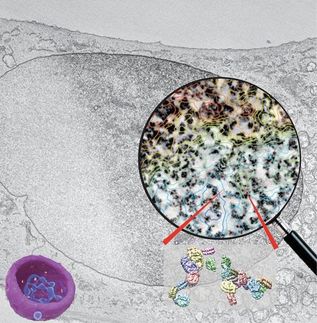The large-scale stability of chromosomes
"Interphase" refers to the period in the cell cycle in which chromosomes spend most of their time. During this phase, in between mitoses, chromosomes live "dissolved'' in the nucleus where they carry out the processes required for the duplication of genetic material. Our current knowledge regarding the behaviour of chromosomes during interphase is unfortunately quite limited; for example, we would need to know more about the three-dimensional structure of the chromatin filament - the long molecule that makes up the chromosomes and that consists of DNA and other proteins - and how it changes in time and space. The shape of the chromosome is in fact important for its function as it allows or prevents access to portions of genetic code for the duplication processes.

Cromatin
SISSA
In addition to experimental observation, another important method of study is computer simulation, based on theoretical models of chromatin. A new study has extended work done previously, which used a simpler model of chromatin consisting up of a single fibre. In the new study, the filament could be made up of two types of fibre, one thicker and one thinner, in varying proportions. Experimental studies have indeed demonstrated the existence of two main types of chromatin, with thicknesses of 10 or 30 nm. In the study, the scientists made molecular dynamics simulations for model chromosomes in various conditions: they added increasingly large amounts of 10 nm fibre to the homopolymer chromatin, consisting of the stiffer 30 nm fibre only.
The model used in the new study, while a simplification of the real molecule, makes the simulation more realistic. The aim of the study was to evaluate whether small-scale modifications in the chromatin fibre lead to large-scale changes in the behavior of the chromosome. "Even after the introduction of the more flexible second fibre, the chromosome remains spatially stable" explains Ana-Maria Florescu, first author of the study and SISSA research scientist. "More in detail", adds Angelo Rosa, SISSA research fellow who coordinated the work, "we found that reorganization occurs only on spatial scales below 0.1 Mbp (million base pairs) and on time scales shorter than a few seconds".
One significant implication of this study concerns the techniques used for the experimental observation of the fibres: those most commonly used today have inadequate resolution to be able to observe this type of reorganization, so we aim to develop new methodologies (like the FISH technique based on oligonucleotides) able to visualize even genome distances smaller than 0.1 Mbp.
Original publication
Other news from the department science

Get the analytics and lab tech industry in your inbox
By submitting this form you agree that LUMITOS AG will send you the newsletter(s) selected above by email. Your data will not be passed on to third parties. Your data will be stored and processed in accordance with our data protection regulations. LUMITOS may contact you by email for the purpose of advertising or market and opinion surveys. You can revoke your consent at any time without giving reasons to LUMITOS AG, Ernst-Augustin-Str. 2, 12489 Berlin, Germany or by e-mail at revoke@lumitos.com with effect for the future. In addition, each email contains a link to unsubscribe from the corresponding newsletter.


























































